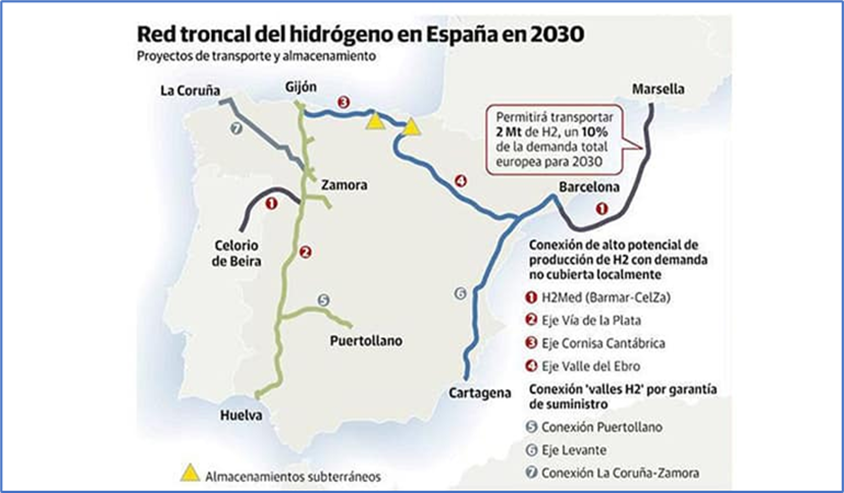The International Association Cedigaz has just released its Hydrogen Market Review: “Spain to become the green hydrogen powerhouse of Europe”, which assesses market developments, policies and prospects of the hydrogen industry in Spain. The report also provides data on Spain’s green hydrogen production projects.
Spain wants to become the European renewable hydrogen hub of Europe. The country holds key assets to realize this ambition, with its abundant sun and wind resources, allowing the cheapest cost of renewable hydrogen in Europe; its vast area available to build renewable power capacity; its well-developed natural gas infrastructure; its ports on key shipping routes; and its industrial asset base and capabilities to adapt a new economy.
Spain adopted a hydrogen roadmap in 2020 to facilitate the deployment and use of hydrogen as a key energy vector for the future. The strategy focuses on renewable hydrogen exclusively. It set the goal of installing 4 GW of electrolysis capacity by 2030, a goal that the government has proposed to increase to 11 GW by 2030 in its draft update of the National Integrated Energy and Climate Plan of June 2023. The focus of the roadmap was mainly on the creation of hydrogen clusters across the country to: i) decarbonise hard-to-abate industries and heavy mobility; ii) stimulate domestic economic activity and revitalize local economies in the Just Transition regions; and iii) become a technological leader in the value chain. Since the Russian invasion of Ukraine and the EU’s ambitious hydrogen vision, the external orientation of Spain’s hydrogen policy has become increasingly prominent. Spain has strengthened its decarbonisation commitment and significantly increased the contribution of renewables, including renewable hydrogen.
The agreement between Spain, France and Portugal to build the H2Med, the first EU green hydrogen corridor, and the subsequent joining of Germany in the project, have created a unique opportunity for the Spanish hydrogen industry. H2Med places Spain, for the first time in history, in a position to become a leading green energy hub from the Iberian Peninsula to central and northern Europe. In addition, thanks to its position on key sea lanes, Spain is poised to become a large producer and exporter of hydrogen derivatives, such as ammonia and methanol. The first preliminary agreements to export ammonia to the Netherlands have already been struck. The creation of sizeable hubs in Spain for green methanol and green ammonia production have been proposed by leading companies.
Driven by these favourable developments, the number of renewable hydrogen projects has jumped since the end of 2022 with several new giga-scale projects announced by Spanish and international corporations. Today, Spain has over 100 renewable hydrogen production projects with a combined capacity above 26 GW at full development. International and Spanish energy and utility companies have committed billions of euros to turn the country into a major renewable hydrogen producer. Together with major consumers, notably in the refining, fertiliser and steel industry, they are developing large hubs across the country to decarbonise hard-to-electrify sectors. Enagás, the transmission system operator, will link these hubs through a national Hydrogen Backbone Network, which is taking shape with the first two axes presented to the EU’s call for Projects of Common Interest.
Helped by state aids, EU funding and private investment, the Spanish renewable hydrogen economy is starting to take shape. However, several regulatory, political, economic and technological challenges remain to be addressed, such as the incomplete regulation; the slow pace of allocation of subsidies at both the national and European levels – whereas financial support is crucial to kick-start early projects; and the additional R&D effort required to reduce costs along the chain. The ambition of Spain will require massive investment in electrolysers, new renewable power capacity, transmission lines and energy storage. It will also require a high level of mobilization of public administrations, as well as a strengthening of their capacities, to speed up the administrative processes. The effort is colossal as it is nothing else than creating a new industry and ecosystem around the hydrogen value chain. The stakes are enormous. Spain has the opportunity to become the green hydrogen powerhouse of Europe, generating a high-added value green economy, contributing to security of supply and advancing the decarbonisation goals of Spain and Europe.
Figure 1 – Spain’s H2 Backbone Network in 2030

Source: Enagás
By Sylvie Cornot-Gandolphe for CEDIGAZ
For more information: contact@cedigaz.org
Cedigaz (International Center for Natural Gas Information) is an international association with members all over the world, created in 1961 by a group of international gas companies and IFP Energies nouvelles (IFPEN). Dedicated to gas information, CEDIGAZ collects and analyses worldwide economic information on natural gas, LNG, renewable gases (hydrogen, biomethane) and unconventional gas in an exhaustive and critical way.
